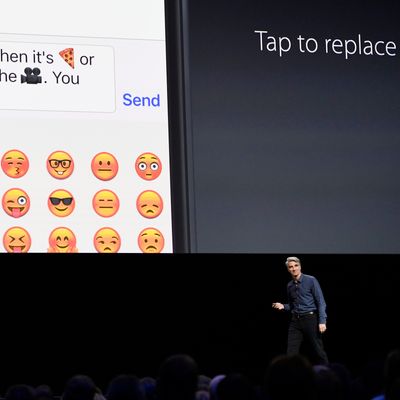
Probably the most important thing that Apple announced at its keynote opening for the Worldwide Developer Conference, on Monday, concerned changes to its Messages app: features that allowed users new ways of interacting with messages. You’ll soon be able to scribble on messages à la Snapchat; react to messages the same way to you can attach emoji to specific posts in Slack; and add visual flourishes, like fireworks, and confetti, and stage lights, that encompass the entire screen.
But that was just a preview of what’s to come. The first-party flourishes were accompanied by an announcement that various aspects of iOS that Apple once ruled with an iron fist were being opened up to developers. New app genres include what amount to plug-ins for the Messages and Maps apps, making third-party functions accessible via first-party programs.
In the past, Apple’s been notoriously strict about what users and developers can and can’t do on its systems, and has kept its own apps sandboxed from everything else. Even as recently as a few years ago, email apps and alternative web browsers were not allowed on the App Store, because Apple refused to allow apps that duplicated functions they already supplied.
Part of the reason Apple has been able to get away with this for so long is because it’s able to, every single year, position the latest iPhone as the new technological paradigm. The idea that developers couldn’t be trusted to use Apple’s tech responsibly was a serviceable argument for Apple’s tyrannical rule. But now that we’re more than a decade into the smartphone era of computing, and now that mobile comprises the lion’s share of web traffic, the argument that users and developers can’t be trusted to administer their phone responsibly rings false. In iOS 10, Apple will finally let you uninstall their Stocks app, because, one might assume, most users can finally be trusted to know how to reinstall it.
Over time, Apple’s slowly relented, allowing browsers like Chrome and email apps like Sparrow, as well as third-party keyboards accessible from any app that requires text input. Extensions eventually allowed users to transmit data between apps, and widgets allowed third parties to present data in the device’s Notification Center. Apple has been very slow to open up iOS to third-party developers, worried about what they’d do after having been handed the keys to the kingdom.
But the announcements by Apple today indicate that, for the most part, it’s done with the infamously strict oversight of what developers can do on iOS devices, and what parts of the phone they can touch. The iPhone is starting to feel like a device that its users and developers have significant control over, whereas in the past Apple has been frustratingly paternal about what it believes users should and should not be able to do.
In a larger sense, the next big tech struggle is on platforms, not hardware. Apple can’t just have great devices; it needs to have a robust software platform that developers feel like they have a stake in. You can see hints of this in Apple’s tweaks to app-store subscription pricing, and further hints as they make concessions to developers and widen the scope of the iOS SDK.
It’s not like Apple deserves a lot of credit for this shift. Widgets, and custom backgrounds, and third-party keyboards have been part of Google’s Android practically since its inception. Apple has been slowly arriving at the conclusions that others have already realized, getting to the heart of a central catch-22 in tech design: Withholding capabilities and options from users can lead to a satisfying and uniform experience across the board, but that uniformity can slowly stagnate. On the other hand, placing options in the hands of users almost always leads to them making choices that developers would like to avoid.
The line between feature use and abuse in tech is thin, almost nonexistent. If users can scribble on every note, or specify a custom background on every message, or integrate yet unseen third-party services, it’s not hard to see that those systems will become what Apple might have previously classified as excessive. Take Android, which has a years-long head start on allowing users to launch third-party apps from links instead of first-party ones (now possible on iOS) and grants users the ability to tweak the system-wide font (iOS now graciously lets users select from a handful of options). Whereas iPhone screenshots can be identified by their uniformity, Android screenshots can be identified by the exact opposite — their highly customizable interface.
Withholding features that seem basic has long been Apple’s best strategy. They’re never a company that’s first to market — always a few years behind, with a more refined take. But the tweaks Apple has managed to introduce into iOS this year have finally tipped the scales away from Apple and toward users and third-party devs. Undoubtedly, developers will offer users a myriad number of customizations and people will flock to them, creating their own personalized, garish phones just as they created eye-burning Myspace profiles a decade ago. User choice trends toward aesthetic choices made by people who are not design professionals. iOS felt uniform in the past because it made all of the design choices for users, but now the floodgates have opened.





























